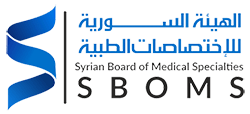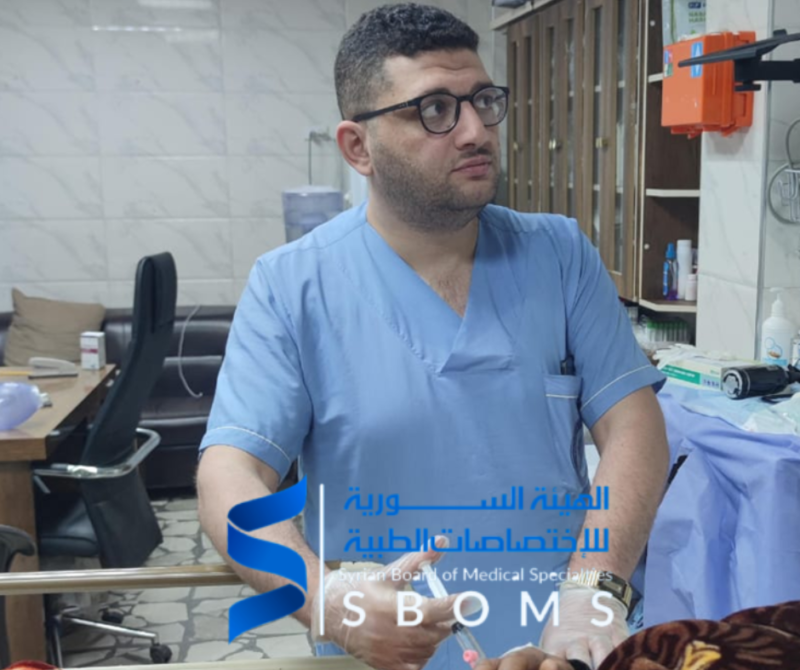History:
A 65-year-old patient visited Idlib Central Hospital, which is supported by the Syrian American Medical Association (SAMS), and Dr. Absi Al-Fouad a resident doctor in the specialty of Neurology met the patient and took the clinical history, which showed that the patient was suffering from sudden weakness of the right upper limb accompanied by heavy tongue 45 minutes ago, the patient is a smoker 40 packets-year. The patient stopped the anticoagulant a week ago for an unknown reason.
- History: hypertension, atrial fibrillation, previous TIA (right paresis about one year ago, that subsided within an hour)
- Pharmacological antecedents: Rivaroxaban, Bisoprolol, Valsartan, Amlodipine
- There is no surgical, family, or allergic history.
Clinical examination:
- Vital signs:
- Arterial pressure: 110/72
- Pulse rate: 55
- Oxygenation SPO2: 94%
- Heat: 36.5
- Respiratory rate: 16
- Neurological examination:
- The patient is conscious responsive orientation, Glasgow 15/15, with symmetrical reactive pupils.Cranial nerve examination within normal.Light dysarthria.Right hemiparesis (upper 2/5, lower 4/5), no swallowing difficulty.Strengths and reflexes within the normal, except for the presence of a positive Babinski reflex in the right side.
- No cerebellar signs, no meningeal signs.
- The examination of the other systems
- Cardiac examination: within normal there are no pathological heart murmurs or friction.
- Chest examination: symmetrical and clear.
- Abdominal examination: soft, breathable, no surgical scars.
- Limb examination: no edema.
Primary investigations:
- ECG: sinus bradycardia
- Chest X-Ray (CXR): within normal
- CT of the brain: No qualitative changes, ASPECT 10 /10
- Laboratory investigations: normal including liver and kidney function, blood count, bleeding and clotting tests, and blood sugar functions.
Management:
The patient was admitted to the intensive care unit, and the criteria for applying thrombosis in the patient were investigated, which found that the patient is eligible for this application. After communicating directly with the supervising doctors on the Stroke unit, who are members of the Syrian American Medical Association and expatriates in the United States of America. The supervising doctor’s recommendation was to apply the TNK for thrombolysis of the thrombosis in the patient, and after Taking informed consent The patient’s thrombolysis was applied according to the dose compatible with his weight, with close monitoring of pressure and with repeated neurological examination within 24 hours of application, the patient’s symptoms decreased within 3 hours, and the paresis completely diminished and the NIHSS became 0 after application, the axial stratification was re-applied after 24 hours, no changes or bleeding were seen, and the anticoagulant was prescribed again to the patient.

The rest of the investigations were completed.
- Cardiac echo showed mild dilation of the left atrium with signs of left ventricular hypertrophy LVH, Ejection Fraction (EF) 55-60%, mild mitral and tricuspid insufficiency
- Doppler showed neck vessels: thickening of the lining walls with carotids, extended gruels causing 35% narrowing of the carotid at both ends and normal flow of the vertebral arteries at both ends.
Follow-up:
• The patient’s condition improved significantly after admission, the patient was discharged after 48 hours and his general condition was good, the neurological examination was normal, vital signs were controlled, NIHSS = 0, with recommendations for performing a computerized tomography (CTA) angiography of the head and neck vessels and review within two weeks.
Discussion:
In this case report, we presented a success story of helping a patient suffering from a stroke with this technique of hemolysis for the first time in the liberated north of Idlib Central Hospital. We noticed a quick improvement in the patient’s symptoms and the complete demise of neurological symptoms as soon as the patient with stroke symptoms was admitted to the hospital with the use of thrombolytic therapy.
The patient in these was a candidate for thrombolytic therapy. Has an acute ischemic stroke (in the middle cerebral artery distribution), has no contraindications to administer thrombotic therapy, and has been evaluated within 4.5 hours of the treatment window since symptom onset. The CT of the head may initially look normal and begin to show extension within 6 to 12 hours after symptoms appear. Exclusion criteria include For the use of thrombolytic drugs include:
- Intracranial hemorrhage on contrast CT (absolute contraindication)
- Symptoms of a simple or rapidly improving stroke
- Clinical suspicion of subarachnoid hemorrhage
- Active internal bleeding during the past 21 days
- A known tendency to bleed.
- Within 3 months of a serious head injury, brain stroke, or intracranial or spinal surgery.
- Within 14 days of major surgery or serious injury.
- Recent arterial puncture in a non-compressible site.
- Lumbar puncture within 7 days.
- A history of intracranial hemorrhage and arteriovenous malformation.
- A seizure occurs at the onset of a stroke.
- A recent myocardial infarction.
- Systolic blood pressure greater than 185 mm Hg or diastolic blood pressure greater than 110 mm Hg.
Reflection:
As part of the training program that residents in the field of neurology go through under the supervision of the Syrian Board of Medical Specializations, this case illustrates the success in diagnosing and treating cerebral thrombosis thanks to a thorough evaluation of the condition and direct communication with expatriate supervisors from the educational committee of the Syrian American Medical Association.
References:
- SROKE: Tenecteplase Thrombolysis for Acute Ischemic Stroke, https://www.ahajournals.org/doi/10.1161/STROKEAHA.120.029749
- National Clinical Stroke Guideline: https://www.strokeguideline.org/chapter/acute-care/?id=190#190

